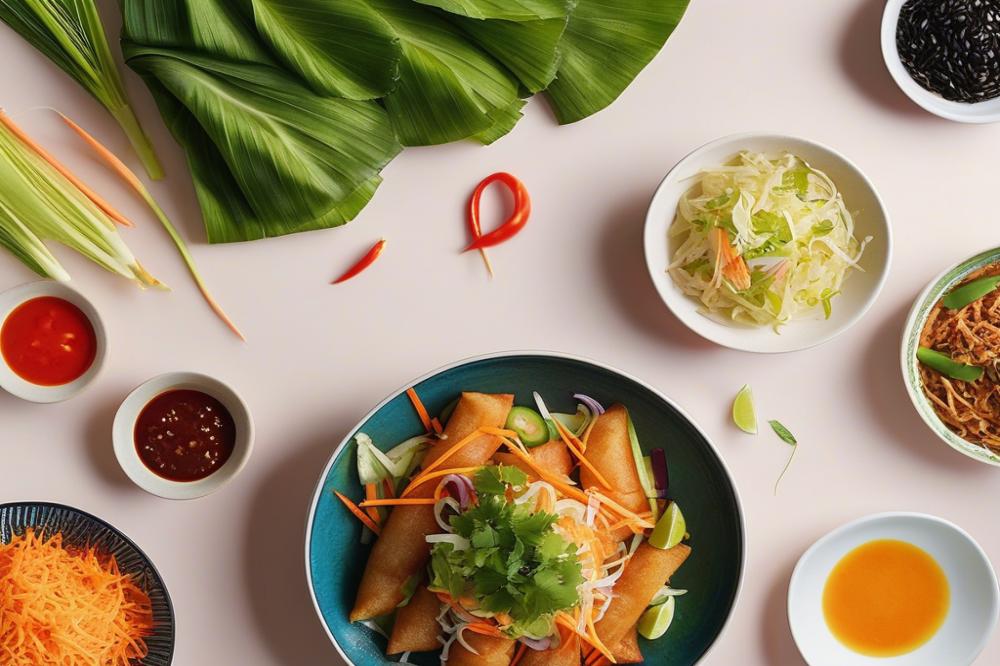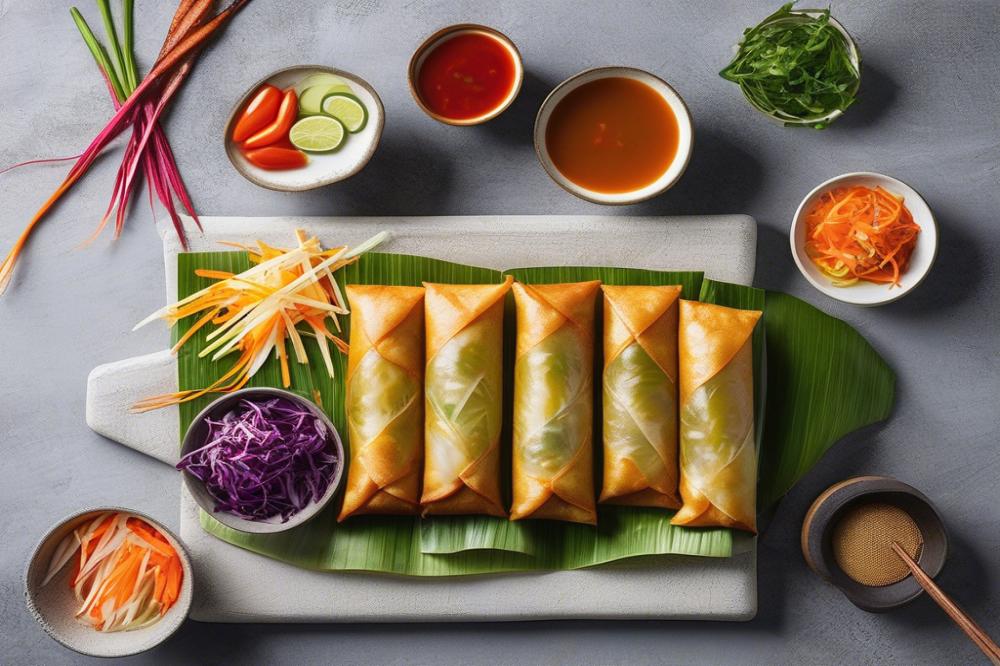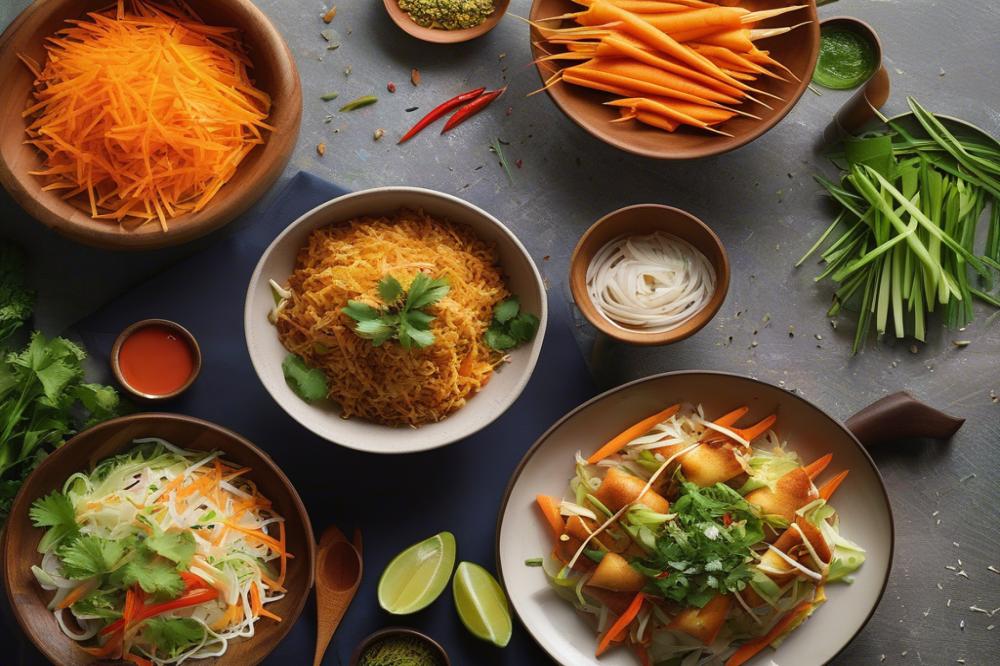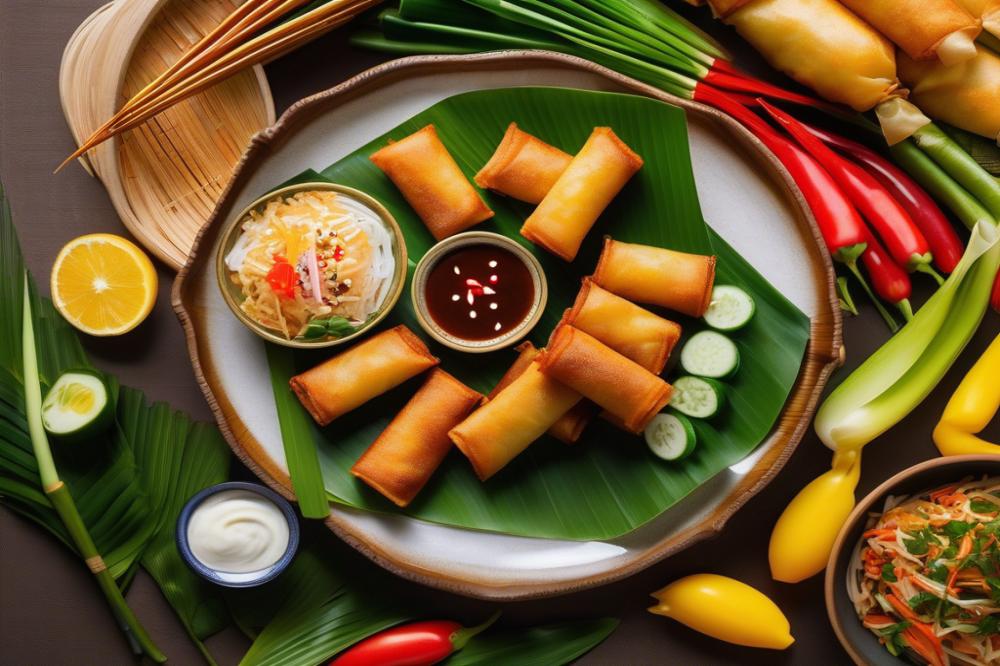Introduction
Popia Goreng is a cherished Malaysian appetizer that brings joy to many. Known for its crispy texture, this flavorful dish has become a staple in Malaysian cuisine. These fried snacks are commonly found in lively street markets, symbolizing the vibrant food culture of the region.
As a popular choice among locals and tourists alike, Popia Goreng showcases the versatility of its fillings. Different ingredients can be used, from vegetables to meats, allowing for various flavor combinations. This adaptability makes it a perfect party food or a tasty treat during gatherings.
When enjoyed fresh and hot, the crunch of the spring rolls delights the palate. Many families love making this homemade recipe, passing down the tradition through generations. Each bite offers a satisfying satisfaction that captures the essence of Asian street food.
What is Popia Goreng

Popia Goreng is a delightful and crispy fried snack popular in Malaysia. This dish consists of thin, delicate wrappers filled with a variety of fillings. Common ingredients include vegetables, meat, and sometimes even seafood. The wrapping is similar to a traditional spring roll but has its own unique characteristics. Each bite reveals a crunchy exterior and a flavorful inside, making it a prized appetizer in Malaysian cuisine.
In comparison to other types of spring rolls, Popia Goreng stands out due to its texture and cooking method. While many spring rolls can be steamed or sautéed, this version is specifically deep-fried, adding a crispy texture that enhances its appeal. Other varieties may feature thicker skins or different fillings, but the essence remains the same: a delicious wrap that bursts with flavor. Each spring roll type has its charm, but Popia offers a particularly satisfying crunch.
Historically, these fried snacks have deep roots in Malaysian culture. They are often found at food stalls, markets, and gatherings, showcasing their role as street food staples. Popiah has Asian origins and has evolved over time, gaining popularity in local cuisines. Families often enjoy a homemade recipe passed down through generations, solidifying their significance during celebrations and parties. Serving them at gatherings brings people together, turning simple moments into cherished memories.
Ingredients and Cooking Instructions

Ingredients
To create delightful spring rolls, gather the following ingredients:
- 10 rice paper wrappers
- 2 cups finely shredded vegetables (carrots, cabbage, and bean sprouts)
- 1/2 cup chopped cooked shrimp or chicken (optional for added flavor)
- 1 tablespoon soy sauce
- 1 teaspoon sesame oil
- A pinch of salt and pepper
- Vegetable oil for frying
Cooking Instructions
The first step is preparing the filling. Start by mixing the shredded vegetables in a large bowl. If you like, add the chopped shrimp or chicken at this point. Pour in the soy sauce and sesame oil, then season with salt and pepper. Combine everything well until the ingredients are evenly coated and flavorful.
Next, take a rice paper wrapper and soak it briefly in warm water until it softens. Lay it flat on a clean surface. Place a spoonful of the filling at one edge of the wrapper. Carefully fold the sides over the filling and roll it up tightly. Repeat this step for the remaining wrappers.
Heat vegetable oil in a deep pan over medium-high heat. You can test the oil by dropping in a small piece of dough; if it sizzles, it’s ready. Fry the filled rolls in batches, making sure not to crowd the pan. Cook until they turn a beautiful golden brown. This should take about 3-4 minutes.
Tips for Achieving a Crispy Texture
To achieve that perfect crispy texture, keep the oil at the right temperature. Too hot, and the outside will burn before the inside cooks. Too cool, and they will absorb more oil and become greasy. Additionally, using fresh rice paper wrappers helps maintain crispiness.
Another tip is to drain the fried snacks on paper towels after removing them from the oil. This will help get rid of excess oil. Serve the popiah hot as a tempting appetizer. They are a delicious part of Malaysian cuisine and make for great party food or casual snacking.
Nutritional Information

Popia Goreng, a beloved fried snack in Malaysian cuisine, offers a delightful combination of flavors and textures. Understanding the nutritional aspects of its ingredients provides insight into its health benefits.
Vegetables
Fresh vegetables are a key element in these spring rolls. They are packed with essential vitamins that contribute to overall health. Leafy greens, carrots, and beansprouts provide a wealth of nutrients. Most importantly, they are low in calories, making this appetizer a guilt-free choice. The fiber in vegetables supports digestion and helps maintain a healthy weight.
Shrimp/Chicken
Shrimp or chicken adds a robust flavor to the rolls and delivers protein, which is vital for muscle repair and growth. A serving can offer a significant amount of protein without an excessive calorie count. Both options contain important minerals and can enhance the dish’s nutritional profile. Choosing lean meats promotes heart health and provides energy throughout the day.
Rice Paper
The rice paper wrappers used in Popiah are an impressive component, too. They provide carbohydrates, which are necessary for energy. These wrappers are also gluten-free, making them suitable for those with gluten sensitivities. This inclusion ensures that diverse dietary needs can be met, allowing more people to enjoy homemade recipes.
Calorie Count and Snacking
When considering the overall calorie count of this dish, it’s important to view it within the context of a balanced meal. Each spring roll can be a satisfying yet portion-controlled option. With a variety of fillings, Popia Goreng can fit into various dietary practices. As a popular choice for Asian street food and party food, it’s a smart way to offer guests a delicious treat without excessive calories.
Enjoying these rolls as a snack can be rewarding. They are versatile, allowing for a creative approach to fillings. This versatility can keep snacking interesting while still nourishing the body. Whether served at gatherings or enjoyed alone, crispy spring rolls strike a balance between indulgence and nutrition.
Serving Suggestions
Popia Goreng makes an excellent choice for party food or as an appetizer. These spring rolls can easily impress your guests. Consider serving them on a large platter for a fun buffet-style experience. When hosting a gathering, you can arrange a variety of fried snacks along with the spring rolls. Not only will this make your spread visually appealing, but it also provides your guests with options. Think about filling some rolls with vegetables, while others could have a meaty filling. Offering a range of flavors can cater to all tastes.
Dipping Sauces
Dipping sauces can elevate the experience of enjoying Popiah. Sweet chili sauce adds a spicy yet sweet kick that pairs perfectly with fried snacks. Alternatively, soy sauce mixed with a splash of lime offers a tangy contrast to the crispy texture. Some people love to create a homemade peanut sauce to serve alongside, adding richness to every bite. You might also opt for a spicy sambal if your guests enjoy extra heat. Be creative with the sauces, and you can even set up a mini-dipping station for fun.
Pairing with Other Dishes
To create a complete meal, pair these spring rolls with other Malaysian cuisine. Consider combining them with dishes like nasi lemak or ayam goreng for a well-rounded feast. Serving alongside char kway teow adds a hearty element. Due to their versatile filling, they complement various flavors. Sharing Popia Goreng with friends while enjoying different dishes creates a social dining experience. Asian street food lovers will appreciate the variety and depth of flavors.
Variations of Popia Goreng
Several fillings can be used in these delightful spring rolls. Commonly, a mixture of vegetables like carrots, jicama, and cabbage features prominently. Some choose to add glass noodles or tofu for a vegetarian option. For those who want a twist, fusion recipes have emerged. Ingredients such as cheese or even spicy Korean kimchi can make for an interesting homemade recipe, appealing to diverse palates.
Regional differences play a significant role in how these fried snacks are crafted. In some areas, cookers include shrimp or chicken for added protein. Others might use various spices or herbs to elevate flavors, reflecting local tastes. The choice of wrapping material can also vary, with some preferring rice paper for a lighter bite.
Adding creative elements to the traditional Popiah allows for a modern touch. Some cooks experiment with different spices, blending flavors from various cultures. Creative chefs might use unusual ingredients like avocado or even chocolate for dessert versions. These adaptations make the dish more exciting and suitable for different occasions, including parties.
Ultimately, each version of this popular appetizer offers something distinct. Whether enjoyed as playful street food or a sophisticated starter, the versatility in preparation makes each serving special. The crispy texture of properly fried rolls makes them irresistible, drawing in diners everywhere.
Final Thoughts on Popia Goreng
Popia Goreng holds a special place in Malaysian cuisine. These delightful fried snacks are not just tasty; they also represent the love and creativity of the food culture in Malaysia. Every bite of these crunchy spring rolls tells a story. The mix of fresh vegetables, seasoned meats, or tofu wrapped in delicate pastry is truly irresistible. Street food vendors often whip them up quickly, making them perfect for on-the-go munching or enjoying as a snack during gatherings.
Trying to make this dish at home can be a rewarding experience. Following a simple recipe, anyone can recreate the satisfying crunch and savory flavors found in local markets. Challenges may arise, but with a little practice, you’ll master the art of rolling and frying. Imagine surprising your family or friends with a plate of homemade Popia Goreng. It will surely impress them and spark joy around the dining table.
Exploring Asian street food culture through cooking is a fantastic way to connect with diverse culinary traditions. Each recipe reveals a piece of history and culture, inviting you to engage with flavors from distant lands. So, why not dive into the world of homemade fried snacks? Experimenting in the kitchen is not just about food; it’s about creating memories and sharing joy with others. Embark on this culinary adventure, and let each dish take you closer to the vibrant tapestry of Asian cuisine.



